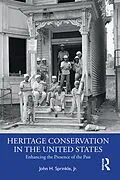Heritage Conservation in the United States begins to trace the growth of the American historic preservation movement over the last 50 years, viewed from the context of the civil rights and environmental movements.
The first generation of the New Preservation (1966-1991) was characterized by the establishment of the bureaucratic structures that continue to shape the practice of heritage conservation in the United States. The National Register of Historic Places began with less than a thousand historic properties and grew to over 50,000 listings. Official recognition programs expanded, causing sites that would never have been considered as either significant or physically representative in 1966 now being regularly considered as part of a historic preservation planning process. The book uses the story of how sites associated with African American history came to be officially recognized and valued, and how that process challenged the conventions and criteria that governed American preservation practice.
This book is designed for the historic preservation community and students engaged in the study of historic preservation.
Autorentext
John H. Sprinkle, Jr. is an Adjunct Assistant Professor at the University of Maryland's School of Architecture, Planning, and Preservation. He has written extensively about the history of historic preservation in the United States.
Klappentext
Heritage Conservation in the United States traces the growth of the American historic preservation movement over the last 50 years, viewed from the context of the civil rights and environmental movements.
The first generation of the New Preservation (1966-1991) in the United States was characterized by the establishment of the bureaucratic structures that continue to shape the practice of heritage conservation in the United States. The National Register of Historic Places began with less than a thousand historic properties and grew to over 50,000 listings. Official recognition programs expanded, causing sites that would never have been considered as either significant or physically representative in 1966 now being regularly considered as part of a historic preservation planning process. The book uses the story of how sites associated with African American history came to be officially recognized and valued, and how that process challenged the conventions and criteria that governed American preservation practice.
This book is designed for the historic preservation community and students engaged in the study of historic preservation.
Inhalt
0. Like Saul on the Road to Damarcus 1. The New Preservation 2. Visibility and Representation 3. Drifting Away from the Truth 4. Districts and Displacement 5. Planning and Process, Awakening and Reaction 6. Heritage Conservation as a Civil Right
